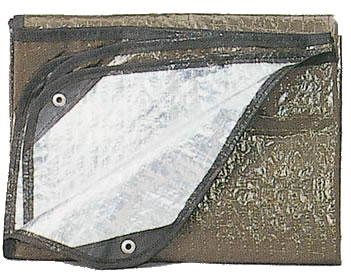Properly Using Emergency Blankets
Emergency blankets, sometimes called space blankets, are found in just about every survival kit on the market today, as well as being available for separate purchase. They can be crucial to survival, provided you understand how to use them properly.
Emergency Blankets are More Like Thin Tarps
 The term "blanket" is actually something of a misnomer. These aren't things you really want to curl up under to watch a movie with your significant other or favorite furry friend. They are more like thin tarps than blankets. Typically, they are made from mylar or similar material and often have a reflective finish on one side. They work by trapping your body heat, preventing it from radiating out into the world.
The term "blanket" is actually something of a misnomer. These aren't things you really want to curl up under to watch a movie with your significant other or favorite furry friend. They are more like thin tarps than blankets. Typically, they are made from mylar or similar material and often have a reflective finish on one side. They work by trapping your body heat, preventing it from radiating out into the world.
Heat is energy and cold is just a lack of that energy being present. If there is no barrier between your skin and the outside air, the heat energy your body produces simply drifts away. Where many animals have a fur coat that helps trap that heat, we don't (except for that one uncle many of us have who has so much body hair that when he steps into a pool it looks like he's suddenly surrounded by kelp). Therefore, we need clothing to keep us warm. In a survival situation, we may end up not having the proper clothing to prevent heat loss. In those cases, we can use an emergency blanket to stay warm.
Common Mistake When Using an Emergency Blanket
The common mistake people make when using emergency blankets is they wrap themselves up tightly, as though they are trying to make a human burrito. While the blanket will certainly keep out the wind and rain, using it in this way won't do much to warm you. Instead, there needs to be some degree of dead air space between you and the blanket. That air is what will warm up as a result of the trapped body heat, and thus keep you warmer. If you have a jacket and such on already, keep those items on your body and wrap the blanket around you. The heavy clothing will serve to create that dead air space you need. In fact, that’s sort of how our winter coats operate already. The fluffy insulating material in the coat creates the air space, then the outer material keeps the heat in.
 If you find yourself lacking a coat or jacket, drape the emergency blanket loosely around you. Tuck it in here and there to prevent drafts but don't wrap it tightly around your body. Either way, if the blanket has a reflective side, keep that directed toward your body.
If you find yourself lacking a coat or jacket, drape the emergency blanket loosely around you. Tuck it in here and there to prevent drafts but don't wrap it tightly around your body. Either way, if the blanket has a reflective side, keep that directed toward your body.
Caution is advised if you’re buying one of the cheap emergency blankets you'll find at the dollar store and similar outlets. Quite often, the material used is so thin, it will wear away along the fold lines over time. Then, just when you need the emergency blanket the most, you'll find you have nothing more than thin ribbons of material. Better to spend the money on quality. After all, your life might just depend upon it!
